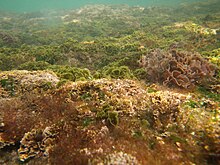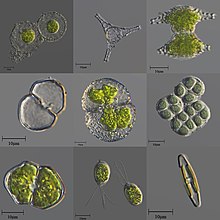**Taxonomy and Classification**:
– Algae are defined by having chlorophyll as their primary photosynthetic pigment.
– Cyanobacteria are often excluded from the algae definition.
– Green algae, red algae, dinoflagellates, and other groups exhibit diverse characteristics.
– Algae lineage relationships are complex and reflect different endosymbiotic events.
– Land plants likely evolved from green algae, making Chlorophyta a sister taxon to plants.
**Reproduction and Physiology**:
– Algae exhibit a wide range of reproductive strategies, from asexual cell division to sexual reproduction.
– Some algae are mixotrophic or have become heterotrophs.
– Algae like Characeae species are used to study various physiological processes.
– Phytohormones are found in algae besides higher plants.
**Ecological Interactions**:
– Algae play a crucial role in oxygen production, carbon sequestration, and nutrient cycling.
– Algae are the base of the food chain in aquatic ecosystems.
– Algae support the growth of coral reefs and contribute significantly to marine biodiversity.
– Algae are used in wastewater treatment processes.
– Algae form symbiotic relationships with various organisms, such as lichens, coral reefs, and sea sponges.
**Industrial and Traditional Applications**:
– Algae have diverse industrial applications, including cattle feed, bioremediation, and algae fuels.
– Algae applications can help in carbon sequestration to mitigate climate change.
– Traditional seaweed farming has existed for thousands of years, especially in East Asia.
– Algae offer value-added products for global economies.
– Algae are studied for their potential in biofuel production, pharmaceutical, and nutritional properties.
**Evolution and Conservation**:
– Algae are polyphyletic, with origins traced back to symbiogenic events over 1.5 billion years ago.
– Fossils suggest land plants may have evolved from charophyte algae.
– Algae conservation efforts are essential for preserving marine ecosystems and overall biodiversity.
– Algae conservation includes protecting endangered species and focuses on sustainable resource management.
– Algae research contributes to understanding ecosystem dynamics and developing sustainable agriculture practices.
Algae (UK: /ˈælɡiː/ AL-ghee, US: /ˈældʒiː/ AL-jee; sg.: alga /ˈælɡə/ AL-gə) are any of a large and diverse group of photosynthetic, eukaryotic organisms. The name is an informal term for a polyphyletic grouping that includes species from multiple distinct clades. Included organisms range from unicellular microalgae, such as Chlorella, Prototheca and the diatoms, to multicellular forms, such as the giant kelp, a large brown alga which may grow up to 50 metres (160 ft) in length. Most are aquatic and lack many of the distinct cell and tissue types, such as stomata, xylem and phloem that are found in land plants. The largest and most complex marine algae are called seaweeds, while the most complex freshwater forms are the Charophyta, a division of green algae which includes, for example, Spirogyra and stoneworts. Algae that are carried by water are plankton, specifically phytoplankton.
| Algae An informal term for a diverse group of photosynthetic eukaryotes Temporal range:
| |
|---|---|

| |
| A variety of algae growing on the sea bed in shallow waters | |

| |
| A variety of microscopic unicellular and colonial freshwater algae | |
| Scientific classification | |
| Domain: | Eukaryota |
| Groups included | |
| |
| Typically excluded | |
| |
Algae constitute a polyphyletic group since they do not include a common ancestor, and although their plastids seem to have a single origin, from cyanobacteria, they were acquired in different ways. Green algae are examples of algae that have primary chloroplasts derived from endosymbiotic cyanobacteria. Diatoms and brown algae are examples of algae with secondary chloroplasts derived from an endosymbiotic red alga. Algae exhibit a wide range of reproductive strategies, from simple asexual cell division to complex forms of sexual reproduction.
Algae lack the various structures that characterize land plants, such as the phyllids (leaf-like structures) of bryophytes, rhizoids of non-vascular plants, and the roots, leaves, and other organs found in tracheophytes (vascular plants). Most are phototrophic, although some are mixotrophic, deriving energy both from photosynthesis and uptake of organic carbon either by osmotrophy, myzotrophy, or phagotrophy. Some unicellular species of green algae, many golden algae, euglenids, dinoflagellates, and other algae have become heterotrophs (also called colorless or apochlorotic algae), sometimes parasitic, relying entirely on external energy sources and have limited or no photosynthetic apparatus. Some other heterotrophic organisms, such as the apicomplexans, are also derived from cells whose ancestors possessed plastids, but are not traditionally considered as algae. Algae have photosynthetic machinery ultimately derived from cyanobacteria that produce oxygen as a by-product of photosynthesis, unlike other photosynthetic bacteria such as purple and green sulfur bacteria. Fossilized filamentous algae from the Vindhya basin have been dated back to 1.6 to 1.7 billion years ago.
Because of the wide range of types of algae, they have increasing different industrial and traditional applications in human society. Traditional seaweed farming practices have existed for thousands of years and have strong traditions in East Asia food cultures. More modern algaculture applications extend the food traditions for other applications include cattle feed, using algae for bioremediation or pollution control, transforming sunlight into algae fuels or other chemicals used in industrial processes, and in medical and scientific applications. A 2020 review found that these applications of algae could play an important role in carbon sequestration in order to mitigate climate change while providing lucrative value-added products for global economies.
